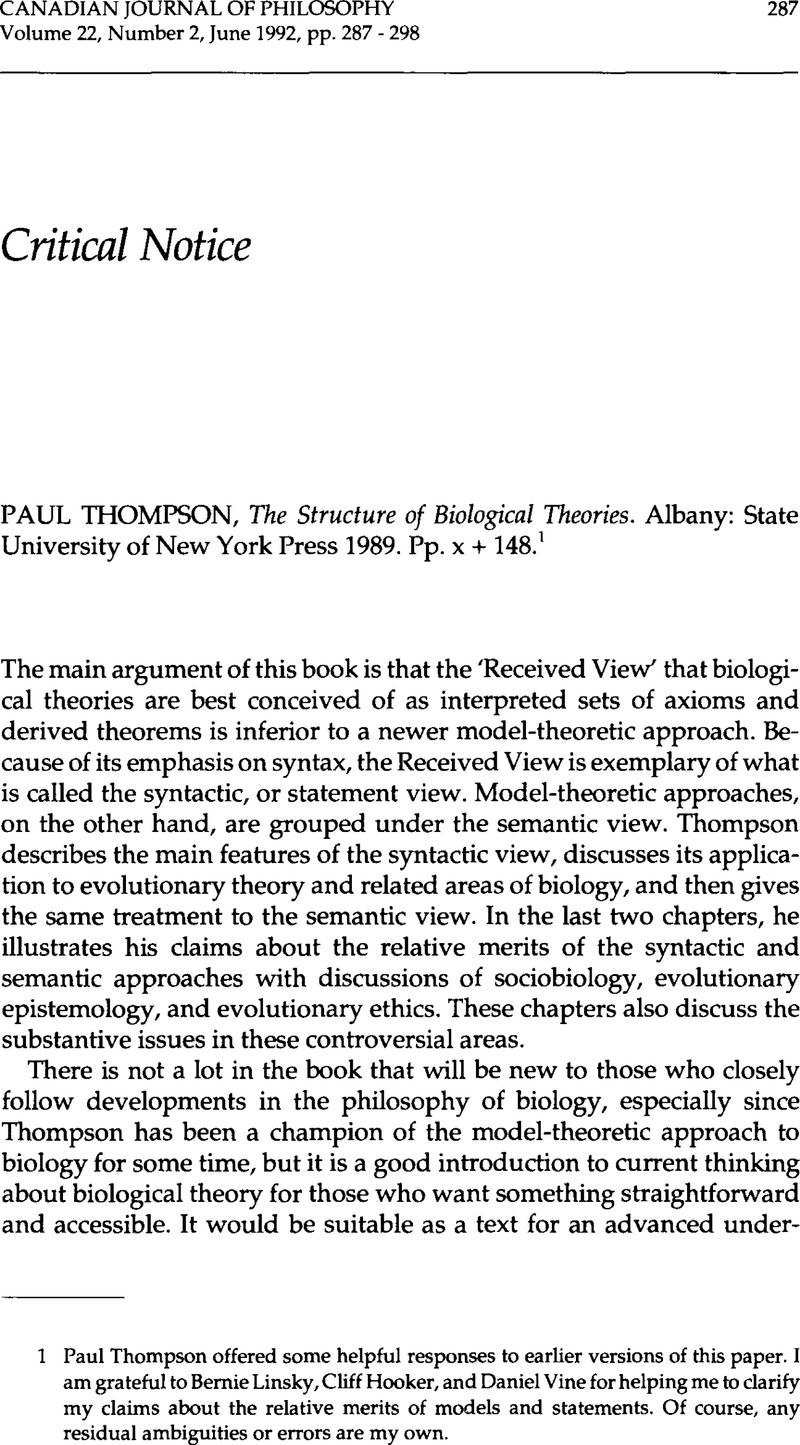Published online by Cambridge University Press: 01 January 2020

1 Paul Thompson offered some helpful responses to earlier versions of this paper. I am grateful to Bernie Linsky, Cliff Hooker, and Daniel Vine for helping me to clarify my claims about the relative merits of models and statements. Of course, any residual ambiguities or errors are my own.
2 Examples are Lloyd, Elizabeth ‘A Semantic Approach to the Structure of Population Genetics,’ Philosophy of Science 50 (1984) 112-29CrossRefGoogle Scholar, The Structure and Confirmation of Evolutionary Theory (New York: Greenwood Press 1988), and ‘A Structural Approach to Defining Units of Selection,’ Philosophy of Science 56 (1989) 395-419; and Beatty, John ‘Optimal-Designing Models and the Strategy of Model Building in Evolutionary Biology,’ Philosophy of Science 47 (1980) 532-61CrossRefGoogle Scholar, ‘What’s Wrong with the Received View of Evolutionary Theory?’ PSA 1980, Vol. 2 (East Lansing: Philosophy of Science Association 1981), and ‘On Behalf of the Semantic View,’ Biology and Philosophy 2 (1987) 17-23. Thompson’s book was preceded by his ‘The Structure of Evolutionary Theory: A Semantic Approach,’ Studies in the History and Philosophy of Science 14 (1983) 215-29, ‘The Interaction of Theories and the Semantic Conception of Evolutionary Theory,’ Philosophica 37 (1986) 73-86, and ‘A Defence of the Semantic Conception of Evolutionary Theory,’ Biology and Philosophy 2 (1987) 26-32.
3 Sloep, Peter B. and van der Steen, Wim J. ‘The Nature of Evolutionary Theory: The Semantic Challenge,’ Biology and Philosophy 2 (1987) 1-16CrossRefGoogle Scholar, and ‘Philosophy of Biology, Faithful or Useful?’ Biology and Philosophy 6 (1991) 93-8; and Ereshef-sky, Marc ‘The Semantic Approach to Evolutionary Theory,’ Biology and Philosophy 6 (1991) 59-80CrossRefGoogle Scholar.
4 The Logical Structure of Mathematical Physics (Dordrecht: D. Reidel 1971)
5 The Structure and Dynamics of Theories (New York: Springer-Verlag 1976), and The Structuralist View of Theories (New York: Springer-Verlag 1979)
6 Suppe, Frederick The Structure of Scientific Theories, 2nd ed. (Urbana: The University of Illinois Press 1976)Google Scholar
7 I discussed this in ‘Revolutionary Change in Science: The Problem of Semantic Comparability’ (unpublished doctoral dissertation, University of Western Ontario 1984). See also Balzer, W. ‘Incommensurability, Reduction and Translation,’ Erkenntnis 23 (1985), 255-67CrossRefGoogle Scholar, and Balzer, W. Moulines, C.U. and Sneed, J.D. An Architectonic for Science (Dordrecht: D. Reidel 1987), 306-20CrossRefGoogle Scholar, in which it is suggested that the best the Structuralist Approach can do is to establish relative degrees of incommensurability.
8 Balzer, Moulines, and Sneed, and references therein.
9 For example, Balzer, W. and Dawe, C.M. ‘Structure and Comparison of Genetic Theories: (1) Classical Genetics,’ British Journal for the Philosophy of Science 37 (1986) 55-69CrossRefGoogle Scholar, and ‘Structure and Comparison of Genetic Theories: (2) The Reduction of Character Genetics to Molecular Genetics,’ British Journal for the Philosophy of Science 37 (1986) 171-91.
10 van Fraassen, B.C. ‘On the Extension of Beth’s Semantics of Physical Theories,’ Philosophy of Science 37 (1970) 325-39CrossRefGoogle Scholar, and Suppe, F. The Semantic Conception of Theories and Scientific Realism (Urbana: The University of Illinois Press 1988)Google Scholar. See also Giere, Ronald Understanding Scientific Reasoning (New York: Holt, Rinehart, Winston 1979)Google Scholar and Explaining Science: A Cognitive Approach (Chicago: University of Chicago Press 1988).
11 Lloyd, 16. These features are also well known to the Structuralists.
12 See, for example, Friedman, Michael ‘Review of Bas C. van Fraassen, The Scientific Image,’ Journal of Philosophy 79 (1982) 276CrossRefGoogle Scholar, n.; and Worrall, John ‘An Unreal Image; Review of Bas C. van Fraassen, The Scientific Image,’ British Journal for the Philosophy of Science 35 (1984) 65-80CrossRefGoogle Scholar. Friedman made the point somewhat more strongly than I have, but did not give an argument for it. Worrall notes that isomorphisms between models require a language in which they can be stated and established. He allows that things are more complicated if we consider second order theories, but typical proponents of the semantic approach have not argued for the need for second order theories. If ‘stated’ means unambiguously represented, and ‘established’ means proven, it is unclear how second order logic will help, because if it is complete it does not have a proof procedure, and vice versa. Worral suggests that the statement and semantic approaches are at best complementary.
13 Stegmiiller made the same point in The Structuralist View of Theories.
14 See Ereshefsky for some examples of how to meet some of the problems.
15 Newman, M.H.A. ‘Mr. Russell’s Causal Theory of Perception,’ Mind 37 (1928) 137-48CrossRefGoogle Scholar; Putnam, H. ‘Models and Reality,’ Journal of Symbolic Logic 45 (1980) 464-82CrossRefGoogle Scholar. The problem is that abstract models can be referred to only by description, but descriptions permit alternative isomorphic interpretations as long as the interpretations have the same cardinality. Distinguishing the interpretations requires attention to the internal properties of the models. Inasmuch as we pick out actual situations in the empirical world as candidates for isomorphism with an abstract model, on the other hand, we must refer to them ostensively (in Russell’s terms, we must know them by acquaintance), so we cannot use their internal properties to pick them out, on pain of circularity. Putnam’s ‘solution’ is to internalize everything, including the empirical world. It is not clear from Putnam’s writings exactly how this ‘solution’ is supposed to bridge the gap between description and ostention.
16 E.g., Brooks, D.R. and Wiley, E.O. Evolution as Entropy: Toward a Unified Theory of Biology, 2nd ed. (Chicago: University of Chicago Press 1988)Google Scholar.